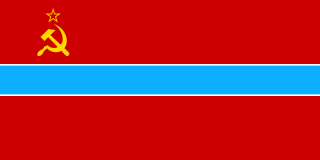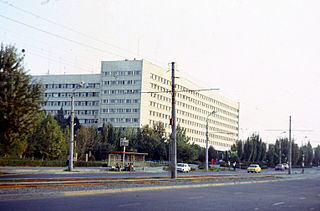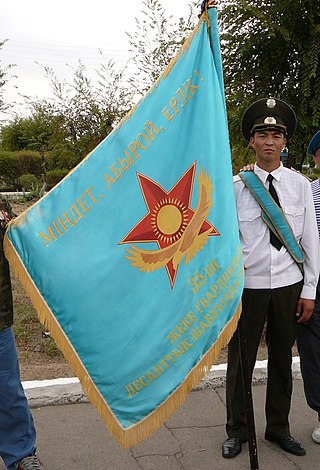
The Uzbek Soviet Socialist Republic, also known as Soviet Uzbekistan, the Uzbek SSR, UzSSR, or simply Uzbekistan and rarely Uzbekia, was a union republic of the Soviet Union. It was governed by the Uzbek branch of the Soviet Communist Party, the legal political party, from 1925 until 1990. From 1990 to 1991, it was a sovereign part of the Soviet Union with its own legislation.

Gudauta is a town in Abkhazia, and a centre of the eponymous district. It is situated on the Black Sea, 37 km northwest of Sukhumi, the capital of Abkhazia. It is the namesake for the Gudauta Bay.

Soviet Central Asia was the part of Central Asia administered by the Soviet Union between 1918 and 1991, when the Central Asian republics declared independence. It is nearly synonymous with Russian Turkestan in the Russian Empire. Soviet Central Asia went through many territorial divisions before the current borders were created in the 1920s and 1930s.

The 106th Guards Tula Red Banner Order of Kutuzov Airborne Division, more generally referred to as the Tula Division, is one of the four airborne divisions of the Russian Airborne Troops, the VDV. Based in the city of Tula, to the south of Moscow, it is administratively located within the Western Military District. в/ч 55599

The Turkestan Military District was a military district of both the Imperial Russian Army and the Soviet Armed Forces, with its headquarters at Tashkent. The District was first created during the 1874 Russian military reform when by order of Minister Dmitry Milyutin the territory of Russia was divided into fourteen military districts. Its first commander was Konstantin Petrovich von Kaufmann, who was also Governor-General of Russian Turkestan at the time.
The Battle for Hill 3234 was a successful defensive battle fought by the 9th Company of the 345th Independent Guards Airborne Regiment, Soviet Airborne Troops, in the Afghanistan against a force of some 250 Mujahideen rebels who were supported by several Pakistani mercenaries in early January 1988. Two of the soldiers killed, Vyacheslav Aleksandrov and Andrey Melnikov, were posthumously awarded the Gold Star of the Hero of the Soviet Union. All of the paratroopers in this battle were given the Order of the Red Banner and Order of the Red Star.

The Transcaucasian Military District, a military district of the Soviet Armed Forces, traces its history to May 1921 and the incorporation of Armenia, Azerbaijan, and Georgia into the Soviet Union. It was disbanded by being redesignated as a Group of Forces in the early 1990s after the Soviet Union collapse. The military district formed as a basis of the modern day armed forces of Armenia, Azerbaijan, and Georgia as well as unrecognized polities of Abkhazia, the Republic of Artsakh and South Ossetia.

The Soviet Airborne Forces or VDV was a separate troops branch of the Soviet Armed Forces. First formed before the Second World War, the force undertook two significant airborne operations and a number of smaller jumps during the war and for many years after 1945 was the largest airborne force in the world. The force was split after the dissolution of the Soviet Union, with the core becoming the Russian Airborne Forces, losing divisions to Belarus and Ukraine.

The 40th Army of the Soviet Ground Forces was an army-level command that participated in World War II from 1941 to 1945 and was reformed specifically for the Soviet–Afghan War from 1979 to circa 1990. The Army became the land forces arm of the Soviet occupational force in Afghanistan in the 1980s, the Limited Contingent of Soviet Forces in Afghanistan.

The 45th Guards Spetsnaz Detached Brigade is a special reconnaissance and special operations military unit of the Russian Airborne Troops (VDV), based near Moscow. It was formed in 1994 as the 45th Independent Spetsnaz Regiment, and expanded to a brigade in 2015.

The 103rd Separate Guards Airborne Brigade is an airborne brigade of the Belarusian Special Forces. Its predecessor unit was the 103rd Guards Airborne Division, which was a division of the Soviet Airborne Troops. It was established in 1946 and disbanded in 1993, a year after its transfer to the Armed Forces of Belarus. The division was formed from the 103rd Guards Rifle Division, which fought as infantry during the final months of World War II in the Vienna Offensive following its formation in late 1944.
The Uzbek Ground Forces are the land component of the Armed Forces of the Republic of Uzbekistan. Operating since the collapse of the Soviet Union in 1991, the army is made up of former Soviet Army units that were in the territory of Uzbekistan. As of 2006, it had around 40,000 active personnel. Much of the equipment it uses is also old Soviet material, and the government of Uzbekistan has not given much effort to replace it with modern equipment.

The 56th Guards Air Assault Regiment is an airborne regiment of the Russian Airborne Troops (VDV). Based at Feodosia in Crimea, the regiment is part of the 7th Guards Mountain Air Assault Division. It was formed in 2021 from the 56th Guards Airborne Brigade, based at Kamyshin. The brigade was first formed in 1979 and fought in the Soviet–Afghan War, the First Chechen War and the Second Chechen War.
The 11th Guards Airborne Division was the name of two separate airborne divisions of the Soviet Airborne Troops. The division was first formed in late 1943 from three airborne brigades and did not see action before its conversion to the 104th Guards Rifle Division nearly a year later. The division was formed a second time in 1948 from a regiment at Ryazan and was disbanded in 1955.
The 105th Guards Airborne Division was an airborne division of the Soviet Airborne Troops.
The 38th Guards Airborne Corps was an airborne corps of the Soviet airborne. It was activated during World War II in August 1944 and became a rifle corps in December of that year. The corps fought in the Vienna Offensive and the Prague Offensive during the spring of 1945. After the end of the war, it was converted back into an airborne corps. The corps served at Tula until its 1955 disbandment when the Soviet airborne was reorganized.

The 35th Guards Air Assault Brigade is an airmobile brigade of the Kazakh Air Assault Forces. It is currently based in Kapchagay. The brigade traces its history back to the Soviet Union as the 111th Guards Airborne Regiment, formed in 1948 as part of the 11th Guards Airborne Division. After the 11th Guards Airborne Division was disbanded in April 1955, the regiment became part of the 105th Guards Vienna Airborne Division. The 105th Guards Airborne Division was broken up in the fall of 1979 and the regiment became the 35th Separate Guards Air Assault Brigade. After the Dissolution of the Soviet Union, the brigade became part of the Armed Forces of the Republic of Kazakhstan and was renamed to the 35th Separate Guards Air Assault Brigade.
Yuri Viktorovich Kuznetsov was a Soviet and Russian military officer who held a number of posts in the Soviet and later Russian Armed Forces, reaching the rank of general-major. He served during the Soviet–Afghan War, receiving the title of Hero of the Soviet Union.

The 15th Independent Special Forces Brigade is an elite unit of the Uzbek Ground Forces, being the successor to its counterpart in the Soviet Army's GRU.












